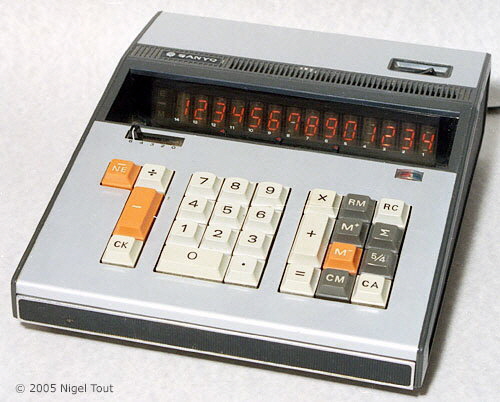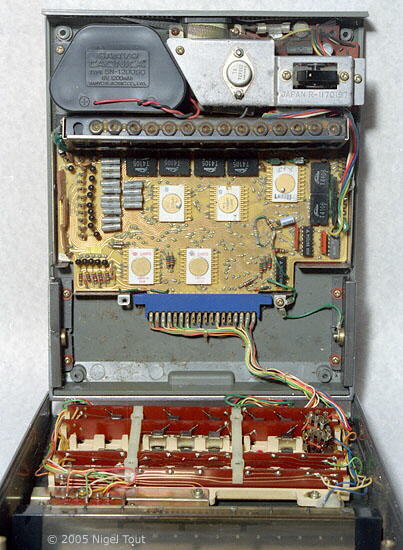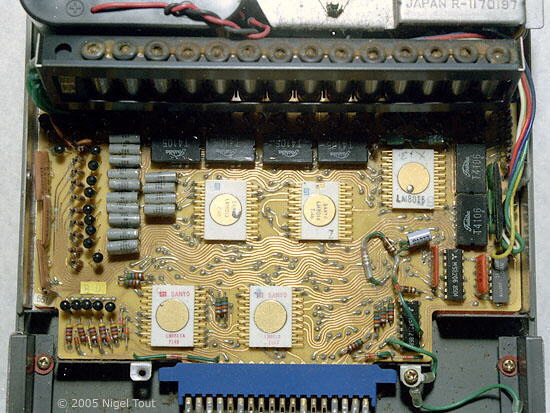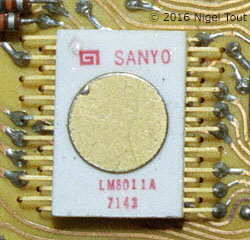Sanyo ICC-1417

Sanyo ICC-1417
Distinctive features: A hybrid portable electronic calculator, with built in AC supply and battery pack. Has battery-level meter.
Technical details:
Display is 14 digits amber gas-discharge tubes.
Four-function, memory. Fixed decimal point, with settings at 0, 2, 3, 4, 6.
Main integrated circuits - Sanyo LM8011A, LM8012, LM803, LM8014, LM8015, all here date coded to end of 1971.
6v sealed rechargeable battery and built in AC adaptor/charger.
227 x 250 x 72 mm (8.9" x 9.8" x 2.8"), 1 Kg (2.2 lbs).
Made in Japan.
Significance: A portable electronic calculator with rechargeable batteries and built-in AC adaptor / charger. With its 14-digit display, this model is the size and weight of a small desktop machine.
The state of development of electronics at this time required five large-scale integrated circuits (LSI) for the four functions and memory.

The cover and keyboard have been hinged up here to reveal the circuit board with the 5 Sanyo LSI chips and the tops of the display tubes. The rechargeable battery pack (rated 6v 1200mAh) is at top left and the AC power supply / recharger is at top right.


As well as having Sanyo markings, four of the white integrated circuits also have General Instruments "GI" markings - these were made by Sanyo under license from General Instruments.
This one is date-coded 1971 week 43.
The Sanyo ICC-1417 uses a chip-set in a similar series but with higher numbers to the Sanyo ICC-0081 and the Sanyo ICC-82D. This was the leading edge of technology at the time, and the developments at Sanyo were reported in the electronics technical magazines:
In April 1969 Electronics reported that[1] "Sanyo Electric Co. is counting on an LSI miniature calculator with a built-in power pack in an effort to gain ground on Hayakawa [Sharp]. Sanyo says it will start sales this fall, just a few months after Hayakawa goes to market with its LSI - but line-powered - machine. The battery pack - four nickel-cadmium rechargeable "C" cells - can run the calculator for three hours before it needs a recharge. Power drain is a mere two watts - 1.2 watts for the two-phase logic circuits and 0.8 watts for the display and its drives, according to Sanyo. Sanyo's cordless machine has 13 different MOS arrays in its logic circuits, plus four transistors, eight resistors, and four capacitors in the clock circuits. The company stoutly insists it will produce the MOS packages itself; insiders in the semiconductor business, though, maintain the Sanyo has had trouble producing bipolar IC's at a reasonable cost and almost certainly will have to turn to U.S. suppliers for MOS arrays."
In a follow up in Sepetember 1969 Electronics reported[2] "Japan's Sanyo Electric Co. is seeking government approval of a licensing arrangement reached with General Instrument Corp. Under the arrangement, Sanyo will at first import and then manufacture the U.S. firm's metal, thick-oxide nitride silicon LSI circuits for use in the Japanese company's new miniature desk calculator. The calculator is expected to go on the market early next year. Terms of the 10-year licensing arrangement call for General Instrument to receive an $80,000 initial payment and a 3.25% royalty. Although Sanyo will be allowed to sell the LSI circuits separately, the company didn't win an exclusivity clause. Sanyo is investing $4.17 million in new production facilities to manufacture the circuits. Domestic production is expected to start in June; the company's initial goal is 70,000 circuits. The calculator itself has been redesigned so that each machine will require only four or five LSI circuits."
The development problems with the ICs appear to have delayed the introduction of the Sanyo miniature hand-held calculators until about the same time that competitor calculators from Canon (Canon Pocketronic) and Sharp (Sharp QT-8B) appeared. Sanyo was then never quite at the forefront of calculator development. The miniature calculator emerged as the Sanyo IC-82 and the Sanyo 0081 "Mini Calculator", above, using integrated circuits marked with the "GI" logo of General Intruments Microelectronics of the U.S.A.
References
Portable Calculators
Vintage Calculators
Text & photographs copyright, except where stated otherwise, © Nigel Tout 2000-2025.